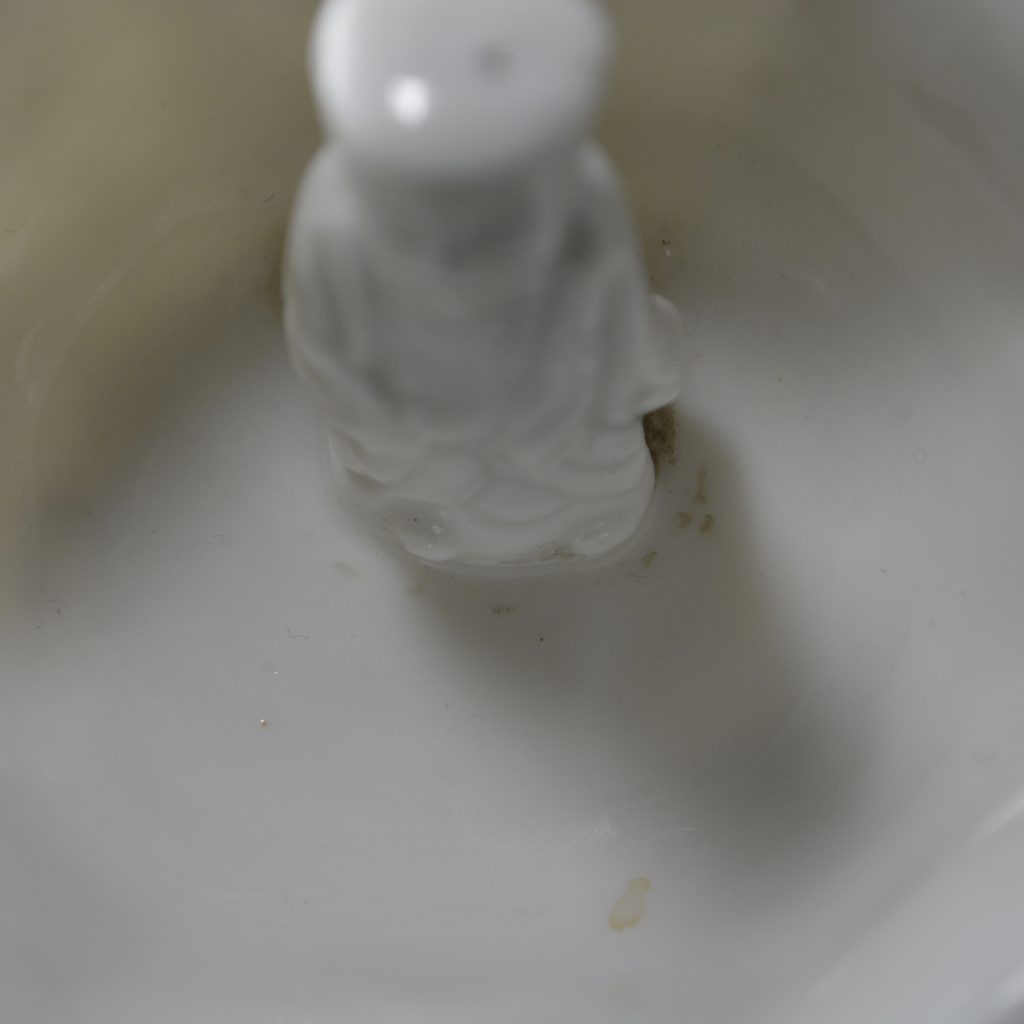
A 17th Century Blanc de Chine Porcelain Trick Cup / Gong Dao Bei, Dehua Kilns, Fujian Province.
A 17th century Blanc de Chine Porcelain ‘Trick Cup’, Dehua kilns, Fujian Province c.1640 – 1680. The external walls are moulded with flowering prunus and in the well of the cup is the Immortal Han Zhongli, One of the `The Eight Immortals` ( Xian).
SOLD
- Condition
- Perfect.
- Size
- Length 8.4 cm (3 1/3 inches)
- Provenance
- N/A
- Stock number
- 115
Information
Trick Cups / Gong Dao Bei :
Trick Cups or `Gong Dao Bei` (`don`t be greedy cup` or `fairness cup`) were wine cups where the wine would drain over the lap of heavy drinker. They illustrate the classical Chinese paradigm that modesty brings gain and arrogance results in loss. If you fill the cup to the top, taking more than your share, every drop will drain out onto your lap through a hole in the bottom, but if you are modest and only fill the cup half full you will be able to drink normally. The earliest cups of this type were made during the Song Dynasty (960-1279) but most are 18th or 19th century. For examples in Blanc de Chine as well as celadon with cobalt-blue and copper-red see our. For more information on trick cups and a description of how they work see : Chinese Puzzles, Games for the Hands and Mind, Traditional Chinese Puzzles from the Yi Zhi Tang Collection (Wei Zhang and Peter Rasmussen, Chinese Culture Center of San Francisco, 2008. ISBN 978-1-58886-101-6) pages 76 and 77.
A Blanc de Chine Porcelain
Trick Cup c.1643
From the "Hatcher Cargo'.
See 'Sold Items'.
The Eight Immortals / Xian :
The Eight Immortals are a group of legendary Xian, immortals or transcendents in Chinese mythology. Each Immortals power can be transferred to a power tool that can give life or destroy evil. Together, these eight tools are called `Covert Eight Immortals`. Most of them are said to have been born in the Tang Dynasty or Song Dynasty. They are revered by the Taoists, and are also a popular element in the secular Chinese culture. They are said to live on Penglai Mountain-Island. The Immortals are : Immortal Woman He (He Xiangu),Royal Uncle Cao (Cao Guojiu),Iron-Crutch Li (LiTieguai),Lan Caihe,Lü Dongbin, (leader)Philosopher Han Xiang (Han Xiang Zi),Elder Zhang Guo(Zhang Guo Lao),and Zhongli Quan.
Plum Blossom / Meihua :
Plum (Prunus), Meihua, is one of the most important plants in Chinese art. Their flowers grow on knurled old angular branches, the flowers are fragile and pure, so they can be a symbol of vigour in old age as well as purity. The tree is the first to flower after the long hard winter, symbolically it can represent perseverance as well as renewal. This meaning is enhanced by a background of cracked-ice, the design can be seen as representing the end of winter and the beginning of spring with the ice of winter cracking to reveal a new year dawning. Branches of plum blossom convey the `Five Blessings` Meikai wufu, longevity, wealth, health, love of virtue and a peaceful death. The number five, an auspicious number to the Chinese, is taken from the five petals of the plum flower.
Blanc de Chine Porcelain :
The porcelain known in the West as Blanc de Chine was produced 300 miles south of the main Chinese kiln complex of Jingdezhen. The term refers to the fine grain white porcelain made at the kilns situated near Dehua in the coastal province of Fujian, these kilns also produced other types of porcelain. A rather freely painted blue and white ware, porcelain with brightly coloured `Swatow` type enamels as well as pieces with a brown iron-rich glaze. However it is the white blanc de Chine wares that have made these kilns famous. The quality and colour achieved by the Dehua potters was partly due to the local porcelain stone, it was unusually pure and was used without kaolin being added. This, combined with a low iron content and other chemical factors within the body as well as the glaze, enabled the potters to produce superb ivory-white porcelain.








